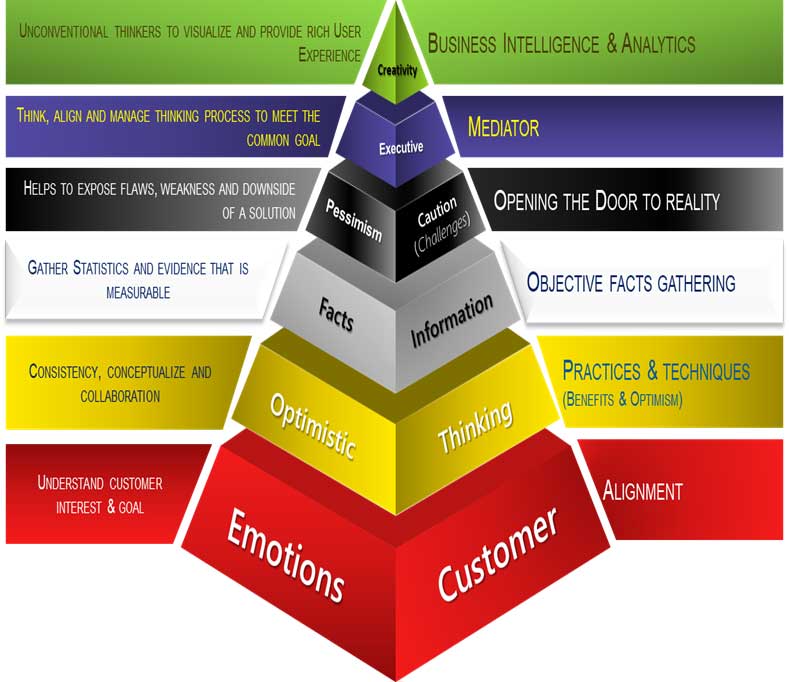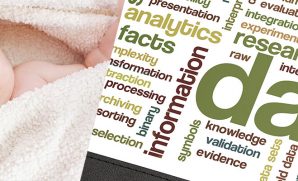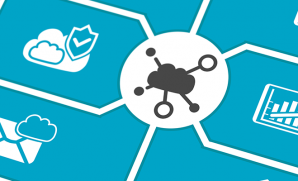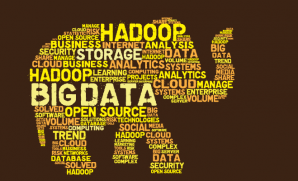Applying SIX THINKING HAT model with BI and analytics for a well-rounded decision-making
Publish Date: August 19, 2019I have always been intrigued by Edward De Bono’s “Six Thinking Hats” theory, how it challenges our habitual thinking and aids lateral thinking process to reach a well-rounded decision. Remarkable case studies are manifesting the success of this theory for decades in corporate decision making. My favorite ones being 3M’s duct tape innovation.
Today as we traverse through the data-driven world, where valuable analysis derived from data, guide our decisions, many of us have become oblivious of this classic theory. I have myself wondered for the longest time if this has lost its relevance in today’s data-driven decision-making process.
Practical applications with clients for many years have reinforced my faith in the pragmatism of this model even in the realms of data, business intelligence, and analytics, reinstating its agelessness. I realized this is what sets us apart from the contemporary peers whose judgments, in most cases, are governed solely by data findings.
Let me break this down for you to elaborate my standpoint:
People often have an ingrained instinctive approach towards decision-making. One pre-dominant instinct, (example: Optimism, pessimism, creativity, etc.) generally subjugates their decision-making ability. Data analytics and business intelligence add rationality to that decision. However, it doesn’t completely rule out the scope of alternative perspective that others in the system may have, sometimes making a decision rather dubious.
For example, a company is trying to deploy advanced technology for their operations. Data analytics and insights dictate that they may run into the risk of declining productivity levels during the first three years, before realizing benefits from this new deployment. If the personality of the decision-maker is naturally optimistic, he may consider this as an opportunity to diversify the production process, disregarding the potential downsides. If he is naturally pessimistic, he may approach with caution, missing out the potential opportunities or failing to take a creative leap to solve the problem.
Lack of consideration of multiple perspectives, (emotional, intuitive, creative or risk management viewpoint,) may result in resistance to a certain decision, lack of innovation and ignoring the need for essential contingency plans.
A good balance between convergent and divergent thinking approaches can be attained by combining the modern data insights derived from BI and analytics along with the golden six thinking hats model, resulting in an all-rounded and unanimous decision. It allows emotion and skepticism to be brought into an otherwise purely rational data insight, yielding creativity, and innovation in decision-making. The metaphorical hats provide a framework for switching between different modes of thinking, challenging the instinctive perspective of a single individual, thereby improving the quality of the decision.
Let me give you a demonstration of our dual role as a leading technology service provider as well as a bearer of the six thinking hats. This is what makes our customer relationship so unique.
- The emotion and intuitive red hat:

Despite the increasing pervasiveness of artificial intelligence mimicking and sometimes even overpowering human cognitive behavior, attributes such as emotions and instincts make us, humans, the supreme being even today. If it were not these feelings, hunches, and intuitions, we would not be able to connect with our fellow humans and make these pathbreaking innovations.
At first we would like to explore the power of this red hat to build the very foundation of our relationship with our customers, understanding their guts, fear or preferences, even if it is devoid of justification. Though the heart-felt nature of red hat is contrary to the innate rationality driven nature of big data and analytics, both can be beautifully amalgamated to determine a crucial business decision. For example, if our client had a hunch about their changing customer behavior, we will follow the hunch and apply statistical analytics to validate the data. We believe such intuitions are necessary value adds for the success of analytics and BI, giving data query the right direction.
- The factual white hat:

Once the perspective of the customers is well-understood, this WHITE HAT’s concentrate on information gathering. They are neutral in presenting facts the way it is. While donning the white hat, you try to assess a situation objectively without any preconceptions, beliefs, or sentiments. The approach is to first consolidate the central repository of all available information of a situation from myriad sources – internal, external, historical, syndicated research, all structured and unstructured data. Once all data is stored and safeguarded as per enterprise set standards for compliances, statistics and evidence are gathered that is measurable to validate a decision.
The white hat bears an uncanny resemblance with the core nature of data analytics, separating facts from noise. It helps in collating minute details from the fundamental stats through mining, cleansing, and programming. This helps answer questions like what information is available, conducts a gap analysis of what is missing and identify who can fill the gap; much like the intelligent insights from BI and analytics. As a matter of fact, it adds sanity to a piece of information in the midst of instinctive and characteristic outpour.
- The optimistic yellow hat:

After evaluating the available information, the team set out to commence with a sunny disposition of the yellow hat, that will ensure consistency in the processes, techniques, and thereby delivery. The role of the yellow hat is also helpful when an analytical insight dictates negative results. This group doesn’t blindly follow the directions to come to a decision, rather evaluate the possible alternatives to work things around in teams favor. This optimistic approach often helps us explore innovative solutions. Wearing the yellow hat prompts us to discover new opportunities and make the best out of it. It helps us highlight the strengths of a certain aspect, bring harmony within the team and enlighten them with its benefits rather than ruling an option out completely in lights of data findings.
- The pessimistic black hat:

The black hat is like an evil twin of the yellow hat. Though pun intended, the role of the black hat bearer is to find counter-argument to a proposal. They play the role of devil’s advocate, assessing a situation with caution and reasoning why it might not work. This hat helps us spot the risks of potential solutions, which otherwise may get unnoticed.
This hat is very critical from an analytical point of view. By challenge the positive data insights, we evaluate if the presented hypothesis is based on sound assumption and matches with the facts. We question a certain analysis at every step, ensuring that there was no data paralysis. It helps us identify flaws, weaknesses, and downside of a solution answering critical questions like how will a decision affect the business most – loss of money, time, or certain customer segments? The role of black hat is apt from a BI and analytics perspective while making forecasts and predictions? It provides a good quality check on data insights setting a golden record. For example – for considering the proposal of opening a new R&D center, the black hat owner will be able to identify if the investment is worth and also question the timelines when the company could start realizing its ROI. However, one must proceed with caution with the judgmental black hat and not overuse it.
- The creative green hat:

Dubbed as the creative hat, the bearer needs to be an unconventional thinker to offer solution outside the box. We play this creative card towards the end when all proposals are made, and different outcomes evaluated. As a role player of this hat, one has to challenge the norm and present unique proposals to address a problem. Solutions that a customer may not have witnessed so far.
It also helps our BI and analytics perspective in identifying new insights that may lead to breakthroughs and fresh ways of thinking.
In this data-heavy, insight-poor world, green hat also helps us develop creative proposals using innovative techniques like visualization and infographic tools. Breaking the data clutter and presenting real insights in a concise graphical way, helps busy executives get a real perspective aiding their decision-making process.
- The executive blue hat:

Mostly donned by executives and managers, the role of the blue hat bearer is to ensure that an amicable decision is reached observing the guidelines of six thinking hats. This hat is used to manage our thinking process, aligning the goal of different proposals, and seeing through the implementation process. This Team takes stock of all the proposals from other hat bearers and organize inputs to develop a final decision. This also eases the data integration and migration process.
From an analytical and BI perspective, this helps us to get a thorough overview of what’s happening in the business and seek impartial answers to questions like what’s next and what outcome are we seeking?
Combining BI and analytics with the all-rounded approach of six thinking hat model brings out a balanced view (both emotional and rational) of a problem. Correlating different thinking styles with data insights and expanding our thinking horizon beyond our innate nature makes our decision more coherent and our relationship with customers more resilient. Next time try this approach for a crucial decision making to experience the difference yourself or contact us to bring out the best of both worlds to you.
Summarizing all the above in a Pyramid Model



















